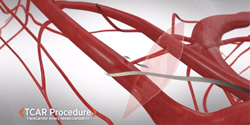Carotid artery disease
What is carotid artery disease?
The carotid arteries supply oxygenated blood to parts of the brain responsible for thinking, speech, movement and the sense of touch. They also supply blood to the eyes. There are two common carotid arteries — each with internal and external branches — on either side of the windpipe. The internal branches supply blood to the brain, while the external branches supply blood to the face and neck.
Atherosclerosis, or a buildup of plaques comprised of cholesterol, calcium and other cellular components, can harden and narrow the arteries, reducing or even completely blocking blood flow to the brain. Smaller pieces of plaque, called emboli, can break off and occlude branch arteries. The most common site for this atherosclerosis is at the point of carotid bifurcation, where the common carotids divide into internal and external branches.
Restricted or blocked blood flow has serious consequences
Ischemia occurs when blood flow to the brain or eye damages cells. An infarction occurs when the cells die. A transient ischemic attack (TIA), or “mini-stroke,” is an ischemic event that results in the temporary loss of brain function. If the resulting loss of brain function is permanent, it’s called a stroke, or "brain attack." Partial or complete blindness in one eye can occur if plaque breaks off and occludes the artery to the eye. This blindness may be temporary (amaurosis fugax) or permanent.
Of all the consequences of carotid artery disease, the most serious is stroke. More than half of all strokes in the U.S. can be attributed to carotid artery disease. A stroke can be caused by a piece of plaque that travels and blocks a portion of the blood flow to the brain, or by a blockage in a carotid artery. It is a leading cause of death and disability, often leaving people unable to talk, use one arm or walk properly.
Symptoms of carotid artery disease and stroke
Carotid artery disease usually has no symptoms. Those at high-risk should be checked periodically by a physician who can listen for an abnormal rushing sound in the neck using a stethoscope. This sound, called a bruit, may indicate the presence of a plaque.
TIAs can cause transient blindness in part or all of one eye and may signal an oncoming stroke. A person experiencing a TIA may have temporary symptoms lasting anywhere from a few minutes to no longer than 24 hours. These symptoms can include:
- Sudden weakness and/or numbness of the arm, leg and/or face on one side of the body
- Slurred speech, difficulty talking or difficulty understanding speech
- Loss of vision in one eye
Because the chances are great that these symptoms may be warning signs of a stroke, anyone experiencing them should seek emergency medical care. Immediate treatment can increase the chances of full recovery.
Risk factors for carotid artery disease
The risk factors for carotid artery disease are those associated with atherosclerosis:
- Smoking
- Hypertension (or high blood pressure)
- Older age
- Gender: men have a higher risk before age 75, while women have a higher risk after age 75
- Family history
- Race or ethnicity
- Genetic factors
- Hyperlipidemia (or elevated fats in the blood)
- Diabetes
- Obesity
Patients known to have atherosclerosis and who are diagnosed with coronary artery disease or peripheral artery disease are at greater risk for carotid artery disease and stroke.
Diagnosing carotid artery disease
An abnormal rushing sound in the neck called a bruit, which can be heard through a stethoscope, may be the first indication of the presence of a plaque.
A special ultrasound of the neck — a carotid artery duplex scan — is the preferred method for both screening and to determine the extent of a blockage. This method produces both an image of the blocked artery and measures the velocity and direction of blood-flow in the vessel. Magnetic resonance angiogram and standard angiograms are also used to diagnose carotid artery disease. A CT scan or MRI study of the brain can confirm if a stroke has occurred.
Treating carotid artery disease
Medication and lifestyle changes
Patients who have narrowing of a carotid artery or a history of stroke or TIAs should quit smoking, eat a heart-healthy diet and exercise regularly. Physicians also may prescribe medication to help control high blood pressure, lower blood cholesterol levels and block the function of platelets.
Surgical treatment: endarterectomy
Severe blockage of a carotid artery (more than 60%) can be repaired by a surgical treatment called carotid endarterectomy. During this procedure, an incision is made in the neck, the plaque is removed and blood flow returns to normal. The procedure has a high success rate. Most patients go home the following day and quickly resume their normal activities.
Endovascular repair: stents
Carotid artery stenting also is used to treat carotid artery disease. It involves the placement of a catheter in an artery of the groin through a small incision in the skin. A balloon is advanced to the neck where it is inflated, dilating the artery wall. A tube-like metal stent is then put in place to keep the artery open and blood flowing. Patients usually stay in the hospital for one or two days and quickly resume normal activities.
The newest option: TCAR
Transcarotid artery revascularization, or TCAR, is the first endovascular or hybrid carotid procedure with outcomes that appear to be equivalent or better than traditional surgical carotid endarterectomy. UC Davis Health was the first health system in the Sacramento region to be named a TCAR Center of Excellence. With TCAR, stents travel less distance, since the process begins with a catheter inserted just above the collarbone rather than the groin. In addition, a special device temporarily reverses carotid blood flow so material loosened during the process travels away from the brain to larger, lower extremity vessels. It greatly reduces the possibility of treatment-related stroke, and it takes up to half the time of traditional procedures.

